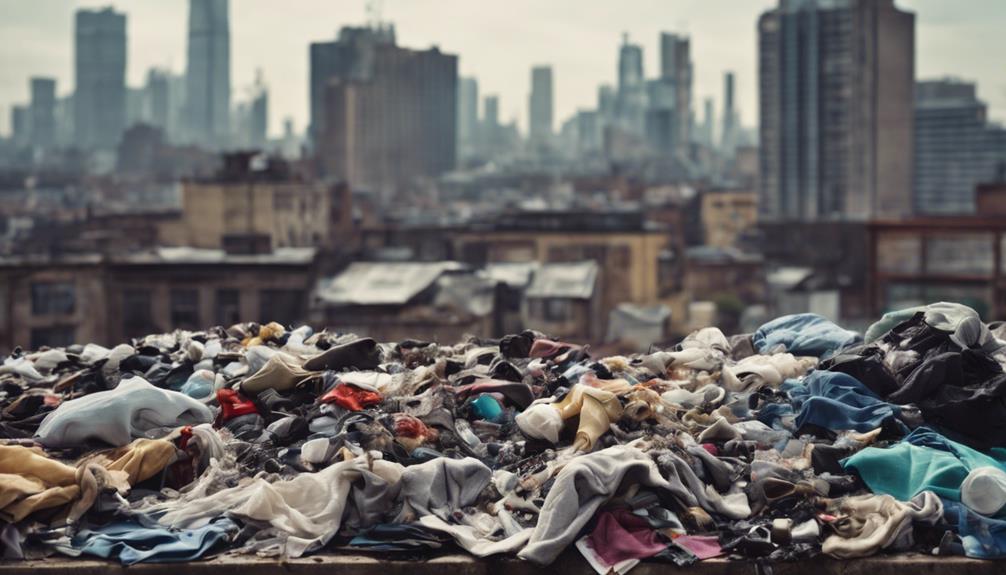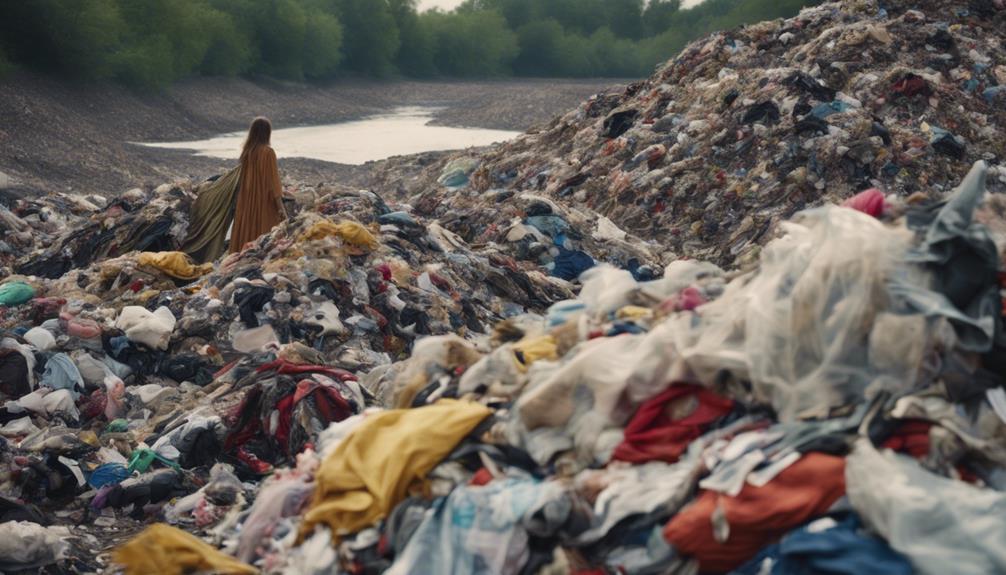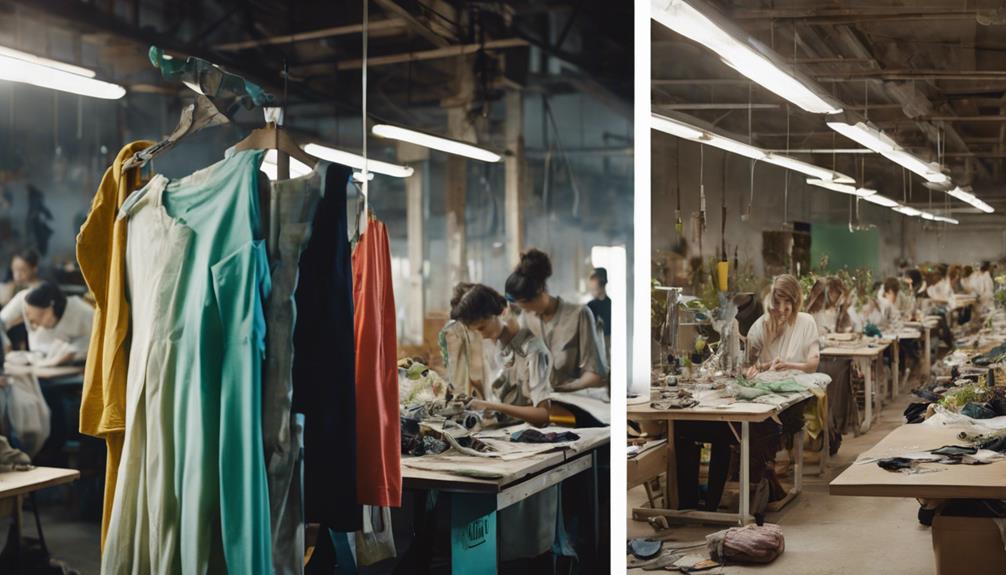Sustainable fashion is important because it helps to address the massive 92 million tons of waste produced by the fast fashion industry each year. By opting for eco-friendly brands, you are endorsing practices that decrease harmful emissions and water pollution. Although many brands claim to be sustainable, they may actually engage in greenwashing to disguise their true impact. Furthermore, adopting community solutions like clothing swaps encourages a more mindful attitude towards fashion. Despite facing obstacles, your awareness can lead you towards making better choices. Understanding the true advantages of sustainable fashion can empower your decisions and contribute to positive changes in the industry. Investing in durable, timeless pieces and prioritizing quality over quantity are key methods of sustainable fashion. By supporting ethical and transparent supply chains, you can ensure that your purchases do not contribute to exploitation or unfair labor practices. Making a conscious effort to reduce, reuse, and recycle in your fashion choices can have a significant impact on the environment and the industry as a whole. Embracing sustainable fashion methods is not only a personal decision but also a powerful statement that can inspire others to make a positive impact.
Key Takeaways
- Sustainable fashion significantly reduces waste, with less than 1% of clothing materials currently recycled, highlighting the need for eco-friendly practices.
- It minimizes environmental impact by addressing the fashion industry's contribution to 20% of global wastewater and 8-10% of greenhouse gas emissions.
- Sustainable practices promote transparency, combating greenwashing and helping consumers identify brands committed to genuine ethical standards.
- Community-based solutions, like clothing swaps, empower consumers to make sustainable choices, fostering collective responsibility and reducing consumption.
Industry Claims Vs. Reality
Despite the fashion industry's claims of sustainability, the reality shows that little has changed regarding environmental impact over the past 25 years. While many sustainable fashion brands promote eco-friendly practices, the majority of clothing items are still made from non-biodegradable materials. This disconnect reveals a troubling gap between marketing and the actual environmental impact of the industry.
You might believe that just because a brand uses recycled materials or promotes a green initiative, it's genuinely sustainable. However, the misconception that sustainability exists on a spectrum leads to the dangerous idea that 'less unsustainable' practices equate to true sustainability. In reality, around 60% of clothing items still end up in landfills or incinerators within a year, exacerbating waste problems and undermining claims of environmental responsibility.
Despite calls for regulatory intervention, market-based solutions have proven insufficient in addressing these sustainability challenges. Without accountability, the fashion industry's commitment to sustainability remains suspect.
It's essential to critically assess the claims of sustainable fashion brands and demand transparency, ensuring that environmental impact isn't just a buzzword but a genuine commitment to change.
Failed Innovations and Strategies

You might think eco-friendly solutions and rental models are game-changers in fashion, but their actual impact is often minimal.
Many brands tout misleading sustainability claims, leaving you questioning what true progress looks like.
It's clear that without significant systemic changes, these innovations won't solve the industry's environmental challenges.
Ineffective Eco-Friendly Solutions
Many eco-friendly innovations in fashion, from bio-based materials to recycling programs, have proven ineffective in making a significant environmental impact. Despite high-profile initiatives, the fashion industry continues to produce massive amounts of waste. For example, less than 1% of clothing materials are recycled, leaving us with a staggering $100 billion annual cost of fashion waste. You might think that rental and resale models like Rent-the-Runway could lead to sustainable and ethical consumption, but they haven't delivered meaningful results either.
The misconception that sustainability exists on a spectrum misleads you into believing that some products are 'less unsustainable.' This perception obscures the reality that true sustainability encompasses more than just eco-friendly fabrics. Many of these materials still require harmful production processes, which negates their perceived benefits.
Ultimately, the reliance on ineffective eco-friendly solutions has stunted progress. As a consumer, it's crucial to recognize that not every sustainable claim holds water. Real change requires a thorough understanding of the fashion industry's lifecycle impacts, not just a superficial commitment to “greener” practices.
Misleading Sustainability Claims
The fashion industry's reliance on misleading sustainability claims has obscured the reality of its ongoing environmental crisis, where innovations like bio-based materials often fail to deliver real change. Despite the buzz around these alternatives, the truth is that 60% of clothing items end up in landfills or incinerators within a year, indicating a systemic issue rather than a superficial fix.
You might think that concepts like Rent-the-Runway contribute to ethical fashion, but they often perpetuate fast fashion's cycle by encouraging constant consumption instead of addressing waste at its root. This misconception that sustainability exists on a spectrum dilutes the urgency for thorough change.
Current strategies like recycling and resale don't effectively reduce the fashion industry's environmental impact, as they fail to align consumer behavior with necessary sustainable practices. Without regulatory intervention, brands will continue to make misleading sustainability claims that lack accountability.
It's time to recognize that true ethical fashion requires more than just marketing buzzwords—it demands a complete overhaul of the industry's practices and values. Real progress means moving beyond these failed innovations and implementing systemic solutions that genuinely prioritize sustainability.
Limited Impact of Rentals
How effective can rental fashion truly be when it often fails to tackle the fundamental issues of overproduction and consumption in the industry? While renting seems like a sustainable alternative to fast fashion, it doesn't address the core problems.
Many rental services still produce garments in large quantities specifically for their collections, leading to increased resource use. Instead of reducing consumption, these services can encourage you to rent more frequently, ultimately perpetuating the cycle of overconsumption.
Moreover, the misconception that renting equates to sustainability overlooks the broader impacts of textile production. Even rented items may end up in landfills after minimal use, contributing to waste rather than mitigating it. Without a significant shift in consumer behavior towards less consumption and more mindful choices, rental fashion can't achieve meaningful sustainability.
In essence, while rental services offer a temporary solution, they often fail to make a lasting impact. The focus should shift from simply renting clothes to rethinking how we consume fashion altogether. Only then can we truly address the environmental challenges posed by fast fashion and move towards a more sustainable future.
Need for Regulatory Intervention

You can't ignore the fact that the fashion industry has a significant environmental impact, and market-based solutions just aren't cutting it.
Without regulatory intervention, brands often sidestep accountability, allowing them to continue harmful practices.
It's clear that enforcing sustainable practices is essential for creating real change in the industry.
Accountability for Environmental Impact
Regulatory intervention is essential for holding the fashion industry accountable for its environmental impact, as voluntary measures have proven insufficient. Despite numerous claims of eco-friendliness, the industry has made minimal progress in sustainability over the past 25 years. Without accountability, companies continue harmful practices, largely ignoring their ethical responsibilities.
Here are three alarming realities that highlight the need for regulations:
- 60% of clothing items end up in landfills or incinerators within a year. This statistic reveals the sheer waste generated by fast fashion.
- Most products are still made from non-biodegradable materials. This means that your clothing could take centuries to decompose, polluting the planet.
- Companies don't bear the costs associated with their environmental damage. This lack of accountability lets them prioritize profits over ethical practices and sustainability.
Market-Based Solutions Ineffective
Market-based solutions have proven inadequate in addressing the fashion industry's environmental crisis, highlighting the urgent need for stronger regulatory intervention. Despite initiatives like recycling and resale, less than 1% of clothing materials are effectively recycled, and the majority of products remain non-biodegradable. This paints a grim picture of sustainability claims in the industry.
Consumer demand for fast fashion exacerbates the problem, leading to 60% of clothing ending up in landfills or incinerators within a year. Without regulatory frameworks, brands lack accountability for their environmental and social impacts, including worker exploitation.
Here's a visual representation of the issues at hand:
| Issue | Market-Based Solutions | Need for Regulatory Intervention |
|---|---|---|
| Recycling Rates | < 1% | Mandate recycling standards |
| Greenhouse Gas Emissions | 8-10% of global total | Enforce emission reduction targets |
| Fast Fashion Demand | Continues to rise | Regulate production practices |
| Waste Management | 60% in landfills | Implement waste reduction policies |
It's clear that relying solely on market-based solutions won't lead to meaningful change. Only with effective regulations can we hold the industry accountable and promote genuine sustainability.
Enforcing Sustainable Practices Needed
The persistent environmental impact of the fashion industry makes it clear that enforcing sustainable practices through strong regulations is necessary to drive real change. You've likely seen how voluntary efforts from companies often fall short, leaving our planet to suffer. Without regulatory intervention, sustainable brands can continue to mislead consumers about their practices.
Consider the following:
92 million tons of fashion waste is generated annually – that's a staggering amount choking our landfills.
71% of millennials prioritize sustainability in their shopping, yet they're left frustrated by misleading claims.
The lack of accountability allows brands to dodge responsibility for their environmental impact, which isn't just unethical – it's unsustainable.
Effects of Fashion Waste

Fashion waste wreaks havoc on the environment, contributing to climate change and polluting water sources with toxic chemicals. You mightn't realize that the fashion industry is responsible for 8-10% of global greenhouse gas emissions, greatly impacting our planet.
When you purchase clothing, keep in mind that about 60% of those items are tossed out within a year, leading to enormous textile waste, often destined for landfills or incinerators. This waste crisis is alarming, with projections estimating that fashion waste will soar to 148 million tons by 2030.
Each garment produced generates 20% of global wastewater, filled with harmful dyes and chemicals that contaminate rivers and oceans. Moreover, synthetic fibers in clothing contribute to microplastics in marine environments, endangering marine life and ultimately entering our food chain.
The impact of fashion waste isn't just a distant concern; it's affecting you and the world around you right now. By understanding these effects, you can make more informed choices, supporting sustainable fashion practices that prioritize the health of our planet and future generations.
Community-Based Solutions

Many communities are finding innovative ways to tackle fashion waste through initiatives like clothing swaps and sharing events. These solutions not only help reduce consumption but also foster community engagement, creating a sense of belonging and collaboration. When you participate in these events, you contribute to a movement that emphasizes sustainability.
Here are three powerful benefits of community-based solutions:
- Strengthened Connections: By sharing resources, you build relationships with others who care about sustainability, creating a supportive network.
- Empowered Choices: You gain access to a rotating wardrobe, allowing you to experiment with styles without the pressure of buying new clothes.
- Environmental Impact: Sharing clothing extends the lifecycle of garments, greatly reducing the environmental impact of fast fashion.
Through these initiatives, you not only reduce your own consumption but also inspire others to rethink their shopping habits. As you engage with your community, you amplify the collective impact of individual actions, promoting a culture of sustainability.
Embracing these community-based solutions is a meaningful step towards a more responsible fashion landscape.
Smart Shopping Practices

When you prioritize smart shopping practices, you not only save money but also make a meaningful impact on the environment.
Start by exploring thrift and consignment stores, which greatly reduce fashion waste. By choosing these options, you help divert garments from landfills, where 60% of clothing items end up within a year of purchase.
Researching ethical brands before you shop guarantees you make informed choices. Studies show that 66% of consumers are willing to pay more for sustainable products, reflecting a shift toward responsible fashion.
Avoid fast fashion retailers, as the apparel and footwear industries contribute 8% of global greenhouse gas emissions.
Invest in timeless, high-quality pieces instead of chasing trends. This approach not only enhances the longevity of your wardrobe but also reduces overall clothing consumption.
Consumer Education and Awareness

Growing awareness about sustainable practices empowers you to make more responsible choices in your wardrobe. As you navigate the fashion landscape, consumer education plays a pivotal role in shaping your decisions. It's important to understand the true impact of your purchases, especially since the fashion industry contributes greatly to global greenhouse gas emissions and waste.
Here are three key reasons to stay informed:
- Environmental Impact: The fashion industry generates 92 million tons of waste annually, so your choices can help reduce this staggering figure.
- Social Responsibility: Many brands exaggerate their sustainability efforts, making it vital for you to discern which brands to support based on ethical practices.
- Recycling Awareness: With only 15% of consumers recycling used clothing, your engagement in responsible disposal can inspire others to follow suit.
Challenges to Sustainable Fashion

Steering through the world of sustainable fashion comes with its own set of challenges that can make ethical shopping feel overwhelming. One of the biggest hurdles you face is consumer reluctance to pay more for sustainable products. Many shoppers prioritize low prices and quick gratification, especially in a fast fashion culture that promotes mass production. This mindset can deter you from making ethical considerations when purchasing clothing.
Additionally, the limited availability of sustainable options in mainstream retail complicates your quest for ethical choices. With many brands still focusing on low-cost items, finding genuine sustainable fashion can be frustrating. Misconceptions about the costs associated with sustainable apparel further cloud your understanding. You mightn't realize that higher wages for workers could minimally impact garment prices.
Lastly, greenwashing tactics employed by brands make it even more difficult to identify truly sustainable options. With misleading marketing practices, you might find it hard to distinguish between what's genuinely ethical and what's simply a marketing ploy. Maneuvering through these challenges is essential if you want to embrace sustainable fashion while making informed choices.
Frequently Asked Questions
Why Is Sustainable Fashion Better?
Sustainable fashion's better because it minimizes environmental harm, promotes ethical production, and encourages longer-lasting garments. By choosing sustainable options, you're actively supporting a healthier planet and driving demand for more responsible practices in the fashion industry.
Do People Really Care About Sustainable Fashion?
Yes, people really care about sustainable fashion. You're part of a growing movement prioritizing eco-friendly options, reflecting values that resonate deeply. Many actively seek brands that align with your commitment to social and environmental issues.
How Is Sustainable Fashion Better Than Fast Fashion?
Sustainable fashion's better because it reduces waste, promotes eco-friendly materials, and supports fair labor practices. You'll find longer-lasting garments that not only help the planet but also keep your wardrobe stylish and ethical.
Why Most of Fashion Today Is Not Sustainable?
Most of fashion today isn't sustainable because it prioritizes quick trends over quality. Fast fashion's low-cost production leads to waste, pollution, and a short lifespan for clothing, leaving a significant environmental footprint that's hard to ignore. Additionally, fast fashion often exploits cheap labor and dangerous working conditions, raising serious ethical concerns. The sustainable fashion truth revealed lies in its emphasis on quality, timeless designs, and eco-friendly materials, which drastically reduce waste and promote longevity. By choosing sustainable brands and practices, consumers can help shift the industry towards a more responsible and conscientious future.
Conclusion
In a world drowning in discarded fabrics and toxic dyes, choosing sustainable fashion feels like a refreshing change.
You're not just wearing clothes; you're wrapping yourself in a story of hope and responsibility.
By embracing eco-friendly choices, you can transform your wardrobe into a canvas of change, where each piece reflects your values.
Imagine walking down the street, not just as a consumer, but as a guardian of the planet's future.
Your choices matter—make them count.









